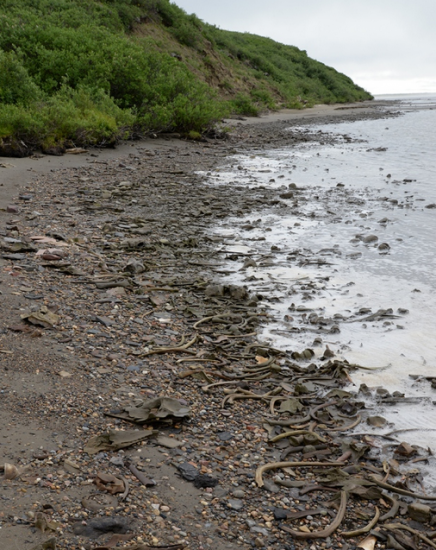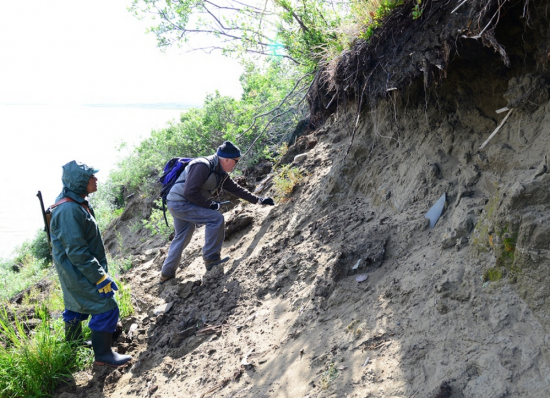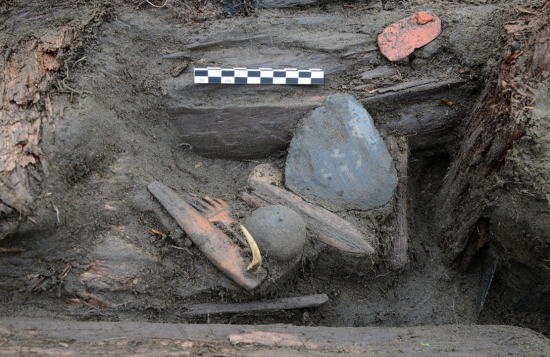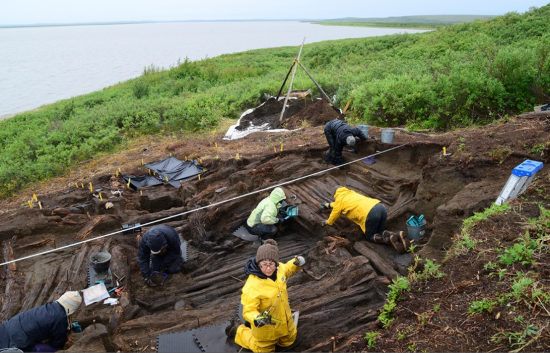Max Friesen hopes to complete excavation before erosion destroys the cruciform pit house
Source - http://www.cbc.ca/news/canada/north/archeologists-unearth-first-complete-inuvialuit-driftwood-house-1.2748364

The beach at the Kuukpak site at low tide, covered in beluga whale bones which are eroding from ancient Inuvialuit houses. (Max Friesen)

Chuck Arnold and Lawrence Rogers examine an eroding Inuvialuit house at the Kuukpak site in the Mackenzie Delta near Tuktoyaktuk, N.W.T. (Max Friesen)

Mike O'Rourke excavates the rear bench of a 19th century house at the Kuukpak site. (Max Friesen)

A cache of artifacts found together in the large cruciform house. At bottom left can be seen a fish hook and a comb; at centre right is an ulu blade made of slate. (Max Friesen)

Letitia Pokiak measures the location of an artifact found while excavating the large cruciform house. Letitia is kneeling on the rear bench of the house, with the main floor and two side benches located behind her. The entrance tunnel, extending downhill toward the Mackenzie River, is in the background and is covered with plastic sheeting so the wood will not dry out. (Max Friesen)
An archeologist from the University of Toronto is celebrating the discovery this summer of the first complete example of a cruciform pit home across from Tuktoyaktuk, N.W.T., in the Mackenzie Delta.
The structures were built by Inuvialuit from about 500 years ago up until around 1900.
"For me, it was almost the capping of my career," says Max Friesen, who’s been working in the area off and on since 1986.
Friesen says large, cruciform houses are one of the things most spoken about in early histories, recollections of elders and the writings of early explorers in the delta
"But even though others have excavated parts of these houses, there’s never been one that’s fully dug, so you can actually see how it all fits together."
They’re called cruciform houses because they have a central floor area and then three very large alcoves, each of which would’ve had one or two different families in them.
"If you look at it from above, it kind of looks like a cross," Friesen says.
Driftwood logs make up the house’s floor, benches and roof, which would have been covered in skin and sod for insulation.
With a main living area about seven metres wide and almost six metres long, the house is almost twice the size as those built by the Thule people, the ancestors of the Inuvialuit.
"By almost any early standard, that’s huge," Friesen says.
He says the house may have been lived in, on and off, for 20, 30 or 40 years. When it was abandoned, it collapsed into the permafrost and became completely frozen.
That makes it horrible to dig in, Friesen says, but it means the structure is wonderfully preserved.
"When you expose some of the wood, it looks like fresh wood. Like something that just drifted in this morning."
Erosion exposing, threatening dig site
Friesen spent five weeks doing the dig this summer at the Kuukpak archeological site that extends about a kilometre along the Mackenzie River.
"It’s probably the single largest Inuvialuit site that was ever occupied," Friesen says. "I would guess at least maybe 40 houses. That’s enormous."
The settlement was the site of a large, very successful beluga hunt every July.
Now, Friesen says, the area is rapidly eroding.
"We could walk on the beach and see a lot of beluga bones and artifacts currently eroding out of the edges of the site and get an amazing view of the size and complexity of what Inuvialuit society must have looked like."
That erosion is putting a time limit on the work.
Friesen says the pit house is so big that 10 people working for five weeks were unable to get to the bottom of it. He plans to head back to the area next year for an aerial survey. Then try to complete the dig in the summer of 2016.
"I’m really hoping that this will last for at least another three, four, five years and that we will manage to preserve a large amount of information that would otherwise be destroyed."